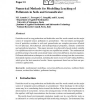Free Online Productivity Tools
i2Speak
i2Symbol
i2OCR
iTex2Img
iWeb2Print
iWeb2Shot
i2Type
iPdf2Split
iPdf2Merge
i2Bopomofo
i2Arabic
i2Style
i2Image
i2PDF
iLatex2Rtf
Sci2ools
AES
2007
Springer
2007
Springer
Numerical methods for modelling leaching of pollutants in soils
Pesticides used in crop production and herbicides used for weed control are the major source of nonpoint-source pollutants to groundwater. The movement and degradation of pesticides residues in soils and groundwater are complex processes affected by soil physical, (bio)chemical and hydrogeological properties, climatic conditions and agricultural practices. This paper presents two physically-based models suitable for equilibrium and two-sites/two-regions non equilibrium models. The mathematical problem arising is basically an unsteady linear convection-diffusion-reaction equation. Different stabilization techniques to avoid the instabilities arising from the convectiondominated regimes are presented, including the more recent of Link-Cutting Bubbles, which gives the best numerical results. Some experiments based on real data are presented as applications.
AES 2007 | Cryptology | Nonpoint-source Pollutants | Physically-based Models | Unsteady Linear Convection-diffusion-reaction |
| Added | 08 Dec 2010 |
| Updated | 08 Dec 2010 |
| Type | Journal |
| Year | 2007 |
| Where | AES |
| Authors | M. Isabel Asensio, B. Ayuso, Luis Ferragut, G. Sangalli |
Comments (0)

